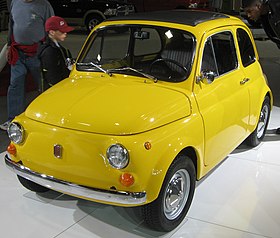| Fiat 500 | |
|---|---|
 1970 Fiat 500 L | |
| Overview | |
| Manufacturer | Fiat |
| Also called | Puch 500 |
| Production | 1957–1975 3,893,294 units[1] |
| Assembly |
|
| Designer | Dante Giacosa |
| Body and chassis | |
| Class | City car (A) |
| Body style |
|
| Layout | Rear-engine, rear-wheel drive |
| Doors |
|
| Related | |
| Powertrain | |
| Engine | |
| Transmission | 4-speed manual |
| Dimensions | |
| Wheelbase |
|
| Length | 2,970 mm (116.9 in) 3,185 mm (125.4 in) (Giardiniera) |
| Width | 1,320 mm (52.0 in) |
| Height | 1,320 mm (52.0 in) |
| Kerb weight | 499 kg (1,100 lb) |
| Chronology | |
| Predecessor | Fiat 500 "Topolino" |
| Successor | |
The Fiat 500 (Italian: Cinquecento, pronounced [ˌtʃiŋkweˈtʃɛnto]) is an economy / city car that was manufactured and marketed by Fiat Automobiles from 1957 until 1975. It was sold as a two-door semi-convertible or saloon car and as a three-door panel van or estate car.
Launched as the Nuova (new) 500 in July 1957,[2] as a successor to the 500 "Topolino", it was an inexpensive and practical small car. Measuring 2.97 metres (9 feet 9 inches) long, and originally powered by a rear-mounted 479 cc two-cylinder, air-cooled engine, the 500 was 24.5 centimetres (9.6 inches) smaller than Fiat's 600, launched two years earlier, and is considered one of the first purpose-designed city cars.[citation needed]
In 1959, Dante Giacosa received a Compasso d'Oro industrial design prize for the Fiat 500. This marked the first time a Compasso d’Oro was awarded to an automotive manufacturer.[3]
- ^ a b c Bouchat, Christian (19 June 2007). "Fifty years since the launch of the Fiat 500 (Part II)". automania.be. Archived from the original on 5 December 2014.
- ^ "Used Car Test: Fiat 500D". Autocar. 818 (130): 49–50. 17 April 1969.
- ^ "Fiat - The people". fcaheritage.com. Retrieved 6 December 2020.